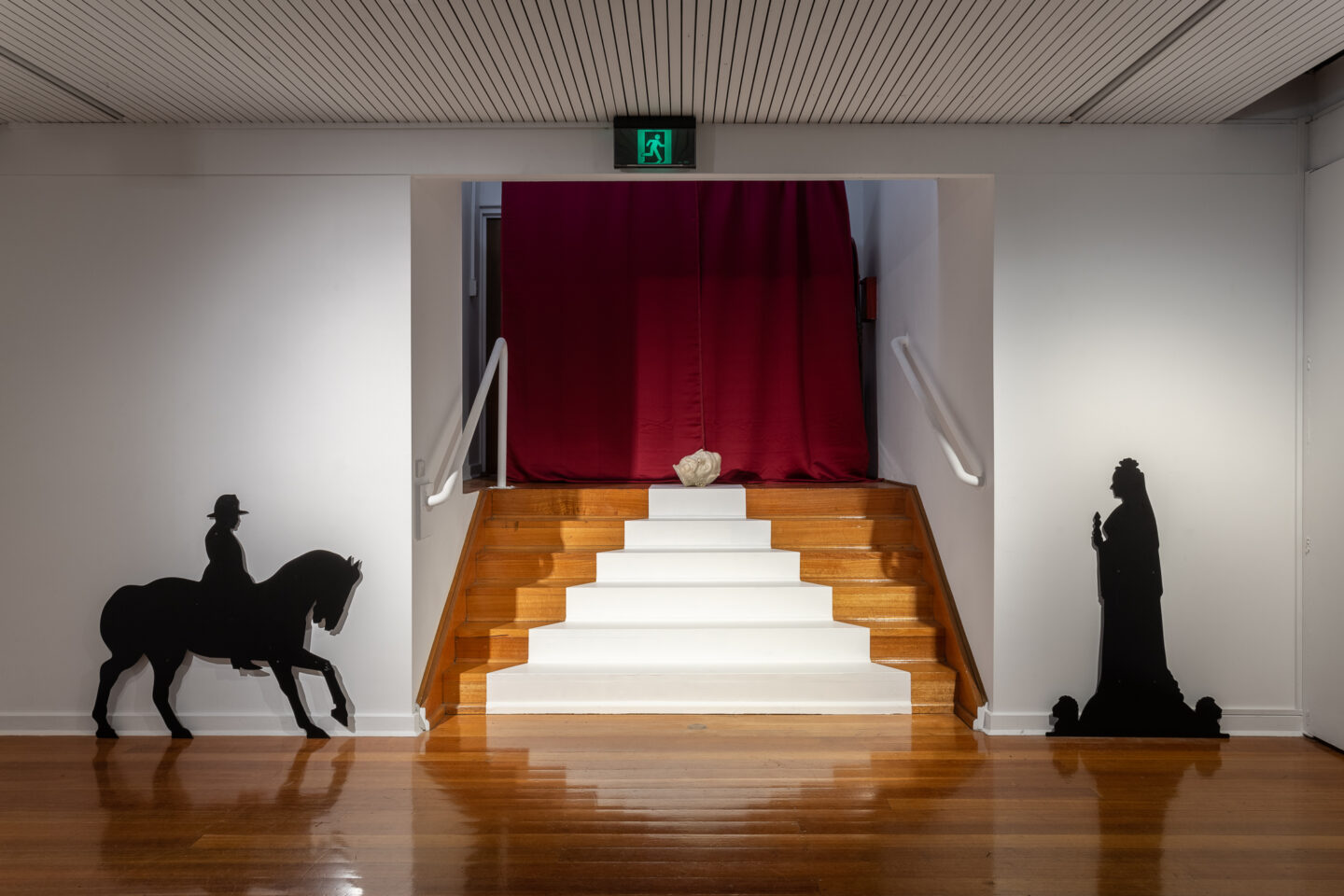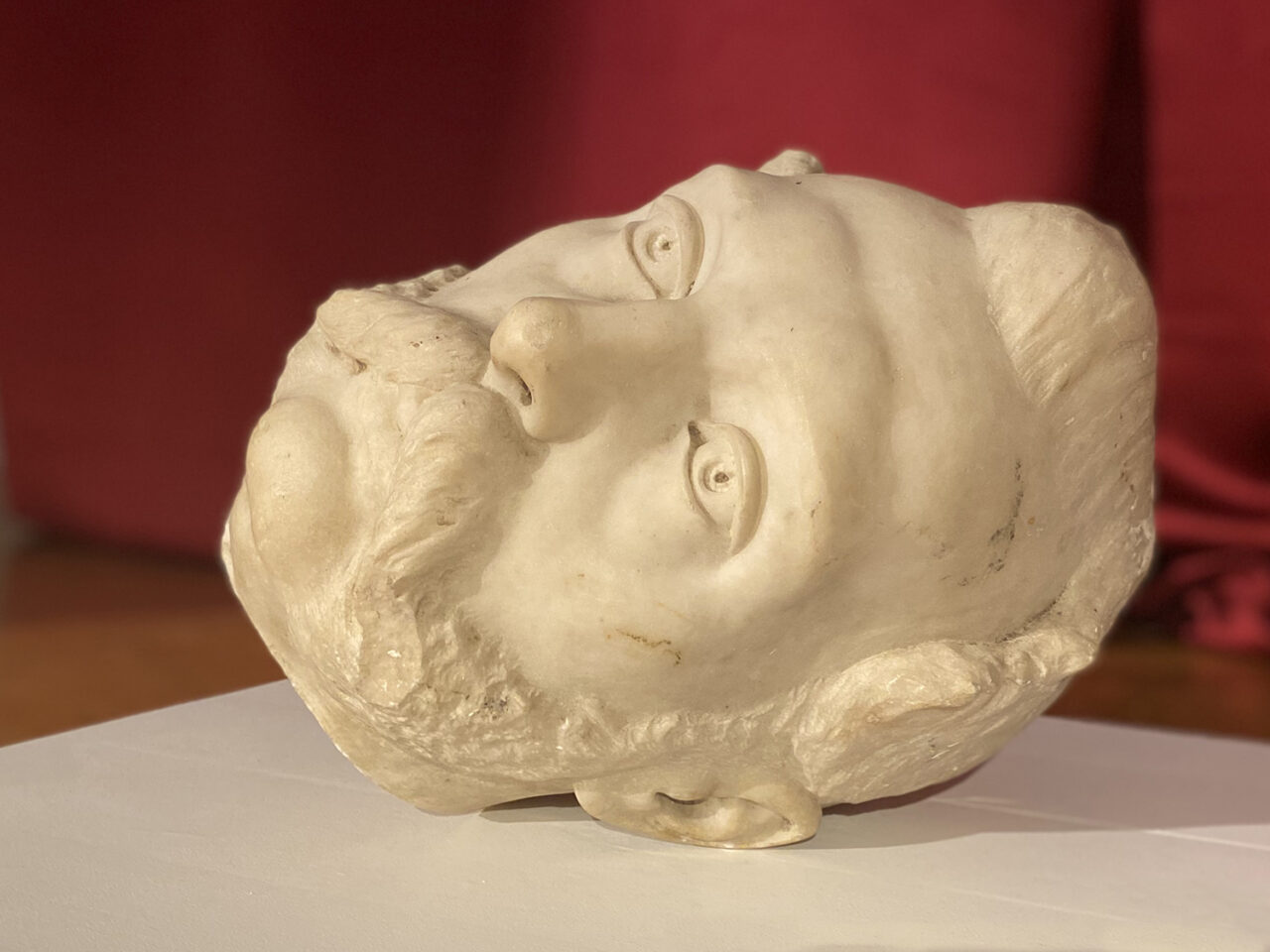Curtain Call
George Paton Gallery
Aluminium composite panels, an original marble head of Russian Emperor Alexander II by Baron Peter Clodt (1805-1867), fabric, adhesive vinyl, acrylic paint, 2020.
Photos by Christo Crocker.
Part of the group exhibition Silences Between Ticks of a Clock: Absence and Erasure in an Age of Cultural Palimpsest
with Rosanna Blacket, Madeleine Lesjak-Atton, Nina Sanadze, Gail Smith, Tina Stefanou and Mimmalisa Trifilò
Curated by Matthew Siddall and Karl Halliday
In an era characterised by mass surveillance, the ‘archival impulse’ and the widespread integration of digital media in our lives – granting all connected a platform to speak and enact – do acts of forgetting, disappearing and silence become forms of resistance? Silences Between Ticks of a Clock invites the critical insight of six graduate Fine Arts students from the Victorian College of the Arts to meditate upon concepts of absence, erasure and temporality.
For full exhibition catalogue click on the line below:
silences between ticks of a clock Catalogue
Curtain Call (2020) by Nina Sanadze
Catalogue text by Karl Halliday
Witnessing first-hand the emancipation of her native Georgia from Soviet governance and the cultural insurrection that ensued, Tbilisi-born artist Nina Sanadze is no stranger to the overwriting of political history. Now based in Melbourne, Sanadze has since developed a practice of rescuing and re-presenting former public monuments to explore how ruling powers employ and destroy visual symbols to reorganise collective memory in support of particular ideological values.
In Curtain Call (2020), a new work by Sanadze commissioned for the exhibition, the artist theatrically decorates a stage for the display of an original marble head of Russian Emperor Alexander II by renowned sculptor Baron Peter Clodt (1805-1867). Decapitated from the Emperor’s body, the head was once part of a colossal public monument installed before the Central Palace in Tbilisi, Georgia sometime between 1855 and the sculptor’s death in 1867. Following the violent Russian Revolution in 1917, leader of the Bolshevik government Vladimir Lenin issued a ‘Plan of Monumental Propaganda’, decreeing that all public vestiges erected in honour of the old Tsarist regime were to be abolished and replaced with monuments propagating the communist ideas of the new reigning command. Soon after, in the early 1920s, Alexander II’s statue fell victim to Lenin’s order and was dismantled and discarded.
Fortunately, the Emperor’s head was salvaged by young sculptor Valentin Topuridze. At risk of his life, Topuridze secretly kept the contraband sculpture in his possession. The head remained hidden within Topuridze’s family home for as long as 40 years following his death, not to be moved again until 2019 when it was shipped to Australia together with Topuridze’s surviving studio archive. Ironically, Topuridze’s own bronze Lenin sculpture would later stand beside the original location of the Emperor, only for the monument to be torn down yet again following the collapse of the Soviet Union in 1991.[1] On either side of the head, the silhouetted figures of Queen Victoria and her son Edward VII watch over the beheaded sculpture like shadows cast from the violence of history.[2]
Curtain Call marks the first time Clodt’s sculpture has been shown in public since the statue was demolished 100 years ago. By restaging the fallen monument, Sanadze showcases a dramatic allegory that equates iconoclasm with cultural amnesia. If history is written by the victors, as the old saying goes, Sanadze offers a platform to those lost, directing our attention to the roles exclusion and erasure play in the reformation of public memory. After all, as Sigmund Freud reminds us, remembering and forgetting are indivisibly connected in that one constitutes the other, and both are derived from the same psychical process – the same has been said about the manufacture of collective memory.[3] However, what is at stake in Curtain Call is not just a concern for rewriting the past. Rather, Sanadze utilises history as an instrument for interrogating the forces of memorialisation that supply our political realities today. In this sense, Curtain Call encourages us to reconsider the master narratives of governments, mainstream media and the powers that be, and to instead look to the ways in which public acts of counter-memory and giving voice to the muted can positively transform future histories to come.[4]
[1] This contextual information was acquired from the artist, whose family had long been in close contact with the Topuridze family.
[2] Queen Victoria and Edward VII were British Royalty during the Emperor’s reign. Edward VII was father to King George V, cousin of the last Russian tsar Nicolas II. For more on the relations between Russian Emperors and British Royalty, see Marc Ferro, Nicholas II: Last of the Tsars, trans. Brian Pearce (Oxford: Oxford University Press, 1991)
[3] Andreas Huyssen, ‘Present Pasts: Media, Politics, Amnesia’ in Public Culture, Vol. 12, No. 1 (Winter 2000), 27
[4] For a brilliant and concise reading on counter-memory practices, see T.J. Demos, ‘Sites of Collective Counter-Memory’, (2012), available online: “http://animateprojectsarchive.org/writing/essays/tj_demos”
To read more about this work please click below:
Farrago » Art Musing: Monumental Questions by Lisa Jacomos

